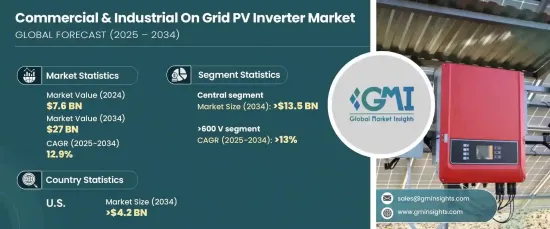PUBLISHER: Global Market Insights Inc. | PRODUCT CODE: 1664903

PUBLISHER: Global Market Insights Inc. | PRODUCT CODE: 1664903
Commercial and Industrial On Grid PV Inverter Market Opportunity, Growth Drivers, Industry Trend Analysis, and Forecast 2025 - 2034
The Global Commercial And Industrial On Grid PV Inverter Market reached USD 7.6 billion in 2024 and is projected to grow at an impressive CAGR of 12.9% from 2025 to 2034. These inverters serve as critical power conversion devices, seamlessly integrating solar photovoltaic (PV) systems into the electrical grid in commercial and industrial environments. By converting direct current (DC) from solar panels into alternating current (AC) compatible with local grid standards, these systems enable efficient solar power utilization within existing energy infrastructures.

| Market Scope | |
|---|---|
| Start Year | 2024 |
| Forecast Year | 2025-2034 |
| Start Value | $7.6 Billion |
| Forecast Value | $27 Billion |
| CAGR | 12.9% |
Favorable government policies, attractive tax benefits, and substantial subsidies supporting renewable energy adoption are set to accelerate the installation of on-grid PV systems in the commercial and industrial sectors. Moreover, rising investments by industry leaders and researchers in developing modern inverters equipped with advanced features-such as real-time monitoring, remote diagnostics, and smart grid compatibility-will fuel market growth. These innovations improve efficiency, reliability, and operational ease, making them indispensable in today's energy landscape.
The central inverter segment is forecast to surpass USD 13.5 billion by 2034, driven by its ability to streamline power conversion in large-scale installations. Centralized systems minimize operational complexity, offering cost-effective solutions with robust durability to withstand the harsh conditions often faced in industrial applications. Additionally, their scalability allows businesses to expand operations without overhauling system architecture, further boosting product adoption in the market.
The > 600 V segment is expected to grow at a robust CAGR of 13% through 2034, owing to the increasing demand for high-capacity applications that require efficient power transmission over longer distances. High-voltage systems reduce energy losses and operational costs, providing businesses with enhanced ROI for solar installations. Furthermore, the rising emphasis on energy security and uninterrupted power supply ensures the growing adoption of these systems, empowering enterprises to maintain reliable energy access during peak loads while minimizing dependence on external sources.
The U.S. commercial and industrial on-grid PV inverter market is anticipated to generate USD 4.2 billion by 2034, fueled by surging energy prices and the rising need for cost-effective alternatives. Frequent grid disruptions caused by extreme weather events are encouraging businesses to adopt advanced inverters with backup capabilities to maintain uninterrupted operations. Additionally, the vast availability of rooftop and ground spaces in industrial parks and commercial establishments positions the U.S. as a lucrative market for on-grid PV inverters.
Table of Contents
Chapter 1 Methodology & Scope
- 1.1 Research design
- 1.2 Base estimates & calculations
- 1.3 Forecast model
- 1.4 Primary research & validation
- 1.4.1 Primary sources
- 1.4.2 Data mining sources
- 1.5 Market definition
Chapter 2 Executive Summary
- 2.1 Industry synopsis, 2021 – 2034
Chapter 3 Industry Insights
- 3.1 Industry ecosystem
- 3.2 Regulatory landscape
- 3.3 Industry impact forces
- 3.3.1 Growth drivers
- 3.3.2 Industry pitfalls & challenges
- 3.4 Growth potential analysis
- 3.5 Porter's analysis
- 3.5.1 Bargaining power of suppliers
- 3.5.2 Bargaining power of buyers
- 3.5.3 Threat of new entrants
- 3.5.4 Threat of substitutes
- 3.6 PESTEL analysis
Chapter 4 Competitive landscape, 2024
- 4.1 Introduction
- 4.2 Strategic dashboard
- 4.3 Innovation & technology landscape
Chapter 5 Market Size and Forecast, By Product, 2021 – 2034 (USD Billion & MW)
- 5.1 Key trends
- 5.2 String
- 5.3 Micro
- 5.4 Central
Chapter 6 Market Size and Forecast, By Nominal Output Voltage, 2021 – 2034 (USD Billion & MW)
- 6.1 Key trends
- 6.2 230 - 400 V
- 6.3 400 - 600 V
- 6.4 > 600 V
Chapter 7 Market Size and Forecast, By Region, 2021 – 2034 (USD Billion & MW)
- 7.1 Key trends
- 7.2 North America
- 7.2.1 U.S.
- 7.2.2 Canada
- 7.3 Europe
- 7.3.1 Germany
- 7.3.2 Italy
- 7.3.3 Poland
- 7.3.4 Netherlands
- 7.3.5 Austria
- 7.3.6 UK
- 7.3.7 France
- 7.4 Asia Pacific
- 7.4.1 China
- 7.4.2 Australia
- 7.4.3 India
- 7.4.4 Japan
- 7.4.5 South Korea
- 7.5 Middle East & Africa
- 7.5.1 Israel
- 7.5.2 Saudi Arabia
- 7.5.3 UAE
- 7.5.4 South Africa
- 7.6 Latin America
- 7.6.1 Brazil
- 7.6.2 Mexico
- 7.6.3 Chile
Chapter 8 Company Profiles
- 8.1 Delta Electronics
- 8.2 Fronius International
- 8.3 GoodWe
- 8.4 Growatt New Energy Technology
- 8.5 Huawei Technologies
- 8.6 SMA Solar Technology
- 8.7 Sungrow Power Supply
- 8.8 Solaredge Technologies
- 8.9 Solis Inverters
- 8.10 V-Guard Industries




